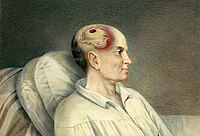
Photo from wikipedia
Importance Most traumatic brain injuries (TBIs) are classified as mild (mTBI) based on admission Glasgow Coma Scale (GCS) scores of 13 to 15. The prevalence of persistent functional limitations for… Click to show full abstract
Importance Most traumatic brain injuries (TBIs) are classified as mild (mTBI) based on admission Glasgow Coma Scale (GCS) scores of 13 to 15. The prevalence of persistent functional limitations for these patients is unclear. Objectives To characterize the natural history of recovery of daily function following mTBI vs peripheral orthopedic traumatic injury in the first 12 months postinjury using data from the Transforming Research and Clinical Knowledge in Traumatic Brain Injury (TRACK-TBI) study, and, using clinical computed tomographic (CT) scans, examine whether the presence (CT+) or absence (CT-) of acute intracranial findings in the mTBI group was associated with outcomes. Design, Setting, and Participants TRACK-TBI, a cohort study of patients with mTBI presenting to US level I trauma centers, enrolled patients from February 26, 2014, to August 8, 2018, and followed up for 12 months. A total of 1453 patients at 11 level I trauma center emergency departments or inpatient units met inclusion criteria (ie, mTBI [n = 1154] or peripheral orthopedic traumatic injury [n = 299]) and were enrolled within 24 hours of injury; mTBI participants had admission GCS scores of 13 to 15 and clinical head CT scans. Patients with peripheral orthopedic trauma injury served as the control (OTC) group. Exposures Participants with mTBI or OTC. Main Outcomes and Measures The Glasgow Outcome Scale Extended (GOSE) scale score, reflecting injury-related functional limitations across broad life domains at 2 weeks and 3, 6, and 12 months postinjury was the primary outcome. The possible score range of the GOSE score is 1 (dead) to 8 (upper good recovery), with a score less than 8 indicating some degree of functional impairment. Results Of the 1453 participants, 953 (65.6%) were men; mean (SD) age was 40.9 (17.1) years in the mTBI group and 40.9 (15.4) years in the OTC group. Most participants (mTBI, 87%; OTC, 93%) reported functional limitations (GOSE <8) at 2 weeks postinjury. At 12 months, the percentage of mTBI participants reporting functional limitations was 53% (95% CI, 49%-56%) vs 38% (95% CI, 30%-45%) for OTCs. A higher percentage of CT+ patients reported impairment (61%) compared with the mTBI CT- group (49%; relative risk [RR], 1.24; 95% CI, 1.08-1.43) and a higher percentage in the mTBI CT-group compared with the OTC group (RR, 1.28; 95% CI, 1.02-1.60). Conclusions and Relevance Most patients with mTBI presenting to US level I trauma centers report persistent, injury-related life difficulties at 1 year postinjury, suggesting the need for more systematic follow-up of patients with mTBI to provide treatments and reduce the risk of chronic problems after mTBI.
Journal Title: JAMA neurology
Year Published: 2019
Link to full text (if available)
Share on Social Media: Sign Up to like & get
recommendations!